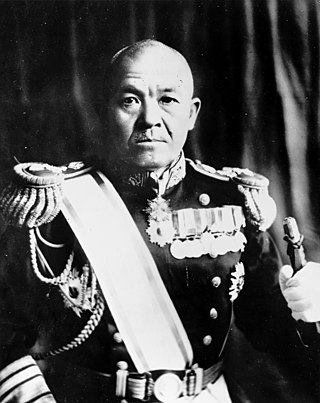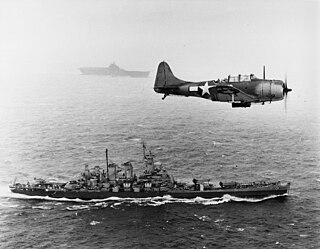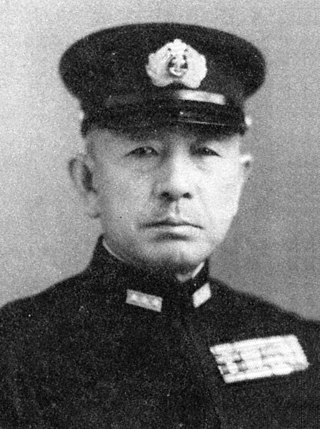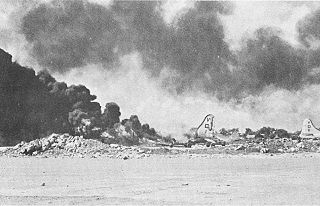
Chūichi Nagumo was an admiral in the Imperial Japanese Navy (IJN) during World War II. Nagumo led Japan's main carrier battle group, the Kido Butai, in the attack on Pearl Harbor, the Indian Ocean raid and the Battle of Midway. He committed suicide during the Battle of Saipan.

The Mariana and Palau Islands campaign, also known as Campaign Plan Granite II, was an offensive launched by United States forces against Imperial Japanese forces in the Pacific Ocean between June and November 1944 during the Pacific War. The campaign consisted of Operation Forager, which captured the Mariana Islands, and Operation Statemate, which captured Palau. Operation Causeway, the invasion of Taiwan was also planned but not executed. The offensive, under the overall command of Chester W. Nimitz, followed the Gilbert and Marshall Islands campaign and was intended to neutralize Japanese bases in the central Pacific, support the Allied drive to retake the Philippines, and provide bases for a strategic bombing campaign against Japan.

The Battle of the Philippine Sea was a major naval battle of World War II on 19–20 June 1944 that eliminated the Imperial Japanese Navy's ability to conduct large-scale carrier actions. It took place during the United States' amphibious invasion of the Mariana Islands during the Pacific War. The battle was the last of five major "carrier-versus-carrier" engagements between American and Japanese naval forces, and pitted elements of the United States Navy's Fifth Fleet against ships and aircraft of the Imperial Japanese Navy's Mobile Fleet and nearby island garrisons. This was the largest carrier-to-carrier battle in history, involving 24 aircraft carriers, deploying roughly 1,350 carrier-based aircraft.

Vice-Admiral Jisaburō Ozawa was an admiral in the Imperial Japanese Navy during World War II. Ozawa held several important commands at sea throughout the duration of the conflict.

The Battle of Saipan was an amphibious assault launched by the United States against the Empire of Japan during the Pacific campaign of World War II between 15 June and 9 July 1944. The battle resulted in the American occupation of the island, putting the Japanese home islands within the range of United States Army Air Forces B-29 bombers and precipitating the resignation of Prime Minister of Japan Hideki Tōjō. It also triggered the Battle of the Philippine Sea, which effectively destroyed Japanese carrier-based airpower.

The Battle of Tinian was part of the Pacific campaign of World War II, fought on the island of Tinian in the Mariana Islands from 24 July until 1 August 1944. The 9,000-man Japanese garrison was eliminated, and the island joined Saipan and Guam as a base for the Twentieth Air Force.

The Battle of Guam was the American recapture of the Japanese-held island of Guam, a U.S. territory in the Mariana Islands captured by the Japanese from the United States in the First Battle of Guam in 1941 during the Pacific campaign of World War II. The battle was a critical component of Operation Forager. The recapture of Guam and the broader Mariana and Palau Islands campaign resulted in the destruction of much of Japan's naval air power and allowed the United States to establish large airbases from which it could bomb the Japanese home islands with its new strategic bomber, the Boeing B-29 Superfortress.

Yoshitsugu Saitō was a lieutenant general in the Imperial Japanese Army during World War II. He commanded Japanese forces during the Battle of Saipan and killed himself during the battle.

Leapfrogging, also known as island hopping, was an amphibious military strategy employed by the Allies in the Pacific War against the Empire of Japan during World War II. The key idea was to bypass heavily fortified enemy islands instead of trying to capture every island in sequence en route to a final target. The reasoning was that those islands could simply be cut off from their supply chains rather than needing to be overwhelmed by superior force, thus speeding up progress and reducing losses of troops and materiel.

The Gilbert and Marshall Islands campaign were a series of battles fought from August 1942 through February 1944, in the Pacific theatre of World War II between the United States and Japan. They were the first steps of the drive across the Central Pacific by the United States Pacific Fleet and Marine Corps. The purpose was to establish airfields and naval bases that would allow air and naval support for upcoming operations across the Central Pacific. Operation Galvanic and Operation Kourbash were the code names for the Gilberts campaign that included the seizures of Tarawa and Makin, during the Battle of Tarawa on 20–23 November 1943 and the Battle of Makin on 20–24 November 1943. Operation Flintlock and Operation Catchpole were aimed at capturing Japanese bases at Kwajalein, Eniwetok, and Majuro in the Marshall Islands.
USS ''LST-84'' was one of the hundreds of Tank landing ships built during World War II to support amphibious military operations. Her role was to carry significant quantities of vehicles, cargo, and troops directly onto an unimproved shore. The ship was sponsored by Mrs. W. Raymond Brendel. The ship was constructed inland at Jeffersonville, Indiana, by the Jeffersonville Boat & Machine Co. as coastal ship yards were used to build larger naval vessels. The ship traversed the Ohio and Mississippi River to reach open water.

Mineichi Koga was a Japanese Marshal Admiral and commander-in-chief of the Imperial Japanese Navy's Combined Fleet.

Shigeru Fukudome was an admiral and Chief of Staff of the Imperial Japanese Navy during World War II.

Saipan International Airport, also known as Francisco C. Ada/Saipan International Airport, is a public airport located on Saipan Island in the United States Commonwealth of the Northern Mariana Islands. The airport is owned by Commonwealth Ports Authority. Its airfield was previously known as Aslito and Isely Field.

The Pacific Ocean theater of World War II was a major theater of the Pacific War, the war between the Allies and the Empire of Japan. It was defined by the Allied powers' Pacific Ocean Area command, which included most of the Pacific Ocean and its islands, while mainland Asia was excluded, as were the Philippines, the Dutch East Indies, Borneo, Australia, most of the Territory of New Guinea, and the western part of the Solomon Islands.
Lieutenant Colonel James M. Cushing was a mining engineer in US Army who commanded the Philippine resistance against Japan on Cebu Island in the Philippines during World War II.
The Allied Translator and Interpreter Section (ATIS), also known as the Allied Translator and Interpreter Service or Allied Translator and Intelligence Service, was a joint Australian/American World War II intelligence agency which served as a centralized allied intelligence unit for the translation of intercepted Japanese communications, interrogations and negotiations in the Pacific Theater of Operations between September 1942 and December 1945. During the last few months of operation ATIS primarily focused on investigation of Japanese war crimes. The section was officially disbanded on April 30, 1946.

During World War II, a series of Japanese air attacks on the Mariana Islands took place between November 1944 and January 1945. These raids targeted United States Army Air Forces (USAAF) bases and sought to disrupt the bombing of Japan by Boeing B-29 Superfortress heavy bombers operating from the islands. The Japanese lost 37 aircraft during this operation, but destroyed 11 B-29s and damaged a further 43. Preparations were also made for commando raids on the bases in early and mid-1945 but these did not go ahead.
The Maritime Heritage Trail – Battle of Saipan is located within the protected waters of Saipan lagoon in the Northern Marianas archipelago. The majority of the dive sites including two Japanese shipwrecks, two Japanese aircraft, two US aircraft, a US landing vehicle and two Japanese landing craft can be found in the clear waters between Garapan, Tanapag Harbor, and Mañagaha Island while further south in Chalan Kanoa Lagoon there are three US tanks.
I-184 was an Imperial Japanese Navy Kaidai type cruiser submarine of the KD7 sub-class commissioned in 1943. During World War II, she operated in the Aleutian Islands and the Central Pacific Ocean before she was sunk with all hands by a United States Navy torpedo bomber during the Battle of the Philippine Sea in June 1944.















